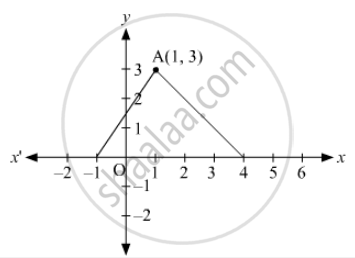Advertisements
Advertisements
प्रश्न
Show that the points (−4, −1), (−2, −4) (4, 0) and (2, 3) are the vertices points of a rectangle.
उत्तर
The distance d between two points (x1 ,y1) and (x2 , y2) is given by the formula
`d = sqrt((x_1 - x_2)^2 + (y_1 - y_2 )^2)`
In a rectangle, the opposite sides are equal in length. The diagonals of a rectangle are also equal in length.
Here the four points are A(−4,−1), B(−2,−4), C(4,0) and D(2,3).
First let us check the length of the opposite sides of the quadrilateral that is formed by these points.
`AB = sqrt((-4 + 2 )^2 + (-1 + 4)^2)`
`=sqrt((-2)^2 + (3)^2)`
` = sqrt(4 + 9)`
`AB = sqrt(13)`
`CD = sqrt((4 - 2)^2 + (0 -3)^2)`
`= sqrt((2)^2 + (-3)^2)`
` = sqrt(4+9)`
`CD = sqrt(13)`
We have one pair of opposite sides equal.
Now, let us check the other pair of opposite sides.
`BC = sqrt((-2-4)^2+(-4-0)^2)`
`=sqrt((-6)^2 + (-4)^2)`
`=sqrt(36 + 16)`
`BC = sqrt(52) `
`AD = sqrt((-4-2)^2 + (-1-3)^2)`
`= sqrt((-6)^2 + (-4)^2)`
`=sqrt(36 + 16) `
`BC = sqrt(52)`
The other pair of opposite sides are also equal. So, the quadrilateral formed by these four points is definitely a parallelogram.
For a parallelogram to be a rectangle we need to check if the diagonals are also equal in length.
`AC = sqrt((-4-4)^2 + (-1-0)^2)`
`= sqrt((-8)^2 + (-1)^2)`
`= sqrt(64+1)`
`AC = sqrt(65)`
`BD = sqrt((-2-2)^2 + (-4-3)^2)`
`= sqrt((-4)^2 + (-7)^2)`
` = sqrt(16+49)`
`BD = sqrt(65)`
Now since the diagonals are also equal we can say that the parallelogram is definitely a rectangle.
Hence we have proved that the quadrilateral formed by the four given points is a rectangle .
APPEARS IN
संबंधित प्रश्न
If three consecutive vertices of a parallelogram are (1, -2), (3, 6) and (5, 10), find its fourth vertex.
Show that the points A (1, 0), B (5, 3), C (2, 7) and D (−2, 4) are the vertices of a parallelogram.
If the points p (x , y) is point equidistant from the points A (5,1)and B ( -1,5) , Prove that 3x=2y
Show that the points A(3,0), B(4,5), C(-1,4) and D(-2,-1) are the vertices of a rhombus. Find its area.
Show hat A(1,2), B(4,3),C(6,6) and D(3,5) are the vertices of a parallelogram. Show that ABCD is not rectangle.
Find the ratio in which the line segment joining the points A(3, 8) and B(–9, 3) is divided by the Y– axis.
If `P(a/2,4)`is the mid-point of the line-segment joining the points A (−6, 5) and B(−2, 3), then the value of a is
The abscissa and ordinate of the origin are
The measure of the angle between the coordinate axes is
The ordinate of any point on x-axis is
The perpendicular distance of the P (4,3) from y-axis is
If the point \[C \left( - 1, 2 \right)\] divides internally the line segment joining the points A (2, 5) and B( x, y ) in the ratio 3 : 4 , find the value of x2 + y2 .
Find the value of a so that the point (3, a) lies on the line represented by 2x − 3y + 5 = 0
If the distance between the points (3, 0) and (0, y) is 5 units and y is positive. then what is the value of y?
If the distance between the points (4, p) and (1, 0) is 5, then p =
If the centroid of the triangle formed by the points (a, b), (b, c) and (c, a) is at the origin, then a3 + b3 + c3 =
In Fig. 14.46, the area of ΔABC (in square units) is

The line segment joining the points A(2, 1) and B (5, - 8) is trisected at the points P and Q such that P is nearer to A. If P also lies on the line given by 2x - y + k= 0 find the value of k.
Point P(– 4, 2) lies on the line segment joining the points A(– 4, 6) and B(– 4, – 6).
If the coordinates of the two points are P(–2, 3) and Q(–3, 5), then (abscissa of P) – (abscissa of Q) is ______.
